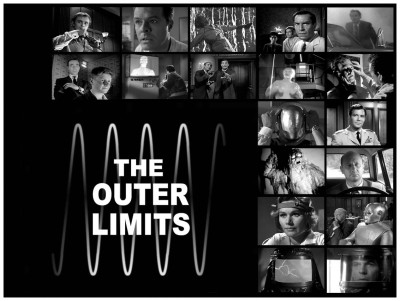 “There is nothing wrong with your television set. Do not attempt to adjust the picture. We are controlling transmission. We control the horizontal, we control the vertical. For the next hour, sit quietly and we will control what you see and hear. You are about to participate in a great adventure. You are about to experience the awe and mystery which reaches from the inner mind to…The Outer Limits.” This was the ultimate monster-of-the-week show. Other series might explore the bizarre or the fantastic with the aim of exciting, amusing or merely arousing dormant grey cells, but this 1963 American anthology series was designed to scare the living daylights out of its audience. Week after week, your television set was taken over by some of the creepiest aliens ever created for the small screen. These weren’t cuddly extraterrestrials, these were full-blooded agents of terror, collectively dubbed ‘Bears’ by producer Joseph Stefano, screenwriter of Alfred Hitchcock‘s Psycho (1960). According to Stefano, the ‘Bear’ is that one splendid, staggering, shuddering effect in a story that induces awe or wonder or terror, and among the most memorable ‘Bears’ were giant bugs with ugly humanoid faces for The Zanti Misfits, living rocks in Corpus Earthling, a shimmering Andromedan conjured up for The Galaxy Being, a flat-faced cyclops in O.B.I.T. and The Invisibles, which were slug-like parasites that burrowed into their human hosts, attaching themselves to the spinal cord and dominating the subject’s will.
“There is nothing wrong with your television set. Do not attempt to adjust the picture. We are controlling transmission. We control the horizontal, we control the vertical. For the next hour, sit quietly and we will control what you see and hear. You are about to participate in a great adventure. You are about to experience the awe and mystery which reaches from the inner mind to…The Outer Limits.” This was the ultimate monster-of-the-week show. Other series might explore the bizarre or the fantastic with the aim of exciting, amusing or merely arousing dormant grey cells, but this 1963 American anthology series was designed to scare the living daylights out of its audience. Week after week, your television set was taken over by some of the creepiest aliens ever created for the small screen. These weren’t cuddly extraterrestrials, these were full-blooded agents of terror, collectively dubbed ‘Bears’ by producer Joseph Stefano, screenwriter of Alfred Hitchcock‘s Psycho (1960). According to Stefano, the ‘Bear’ is that one splendid, staggering, shuddering effect in a story that induces awe or wonder or terror, and among the most memorable ‘Bears’ were giant bugs with ugly humanoid faces for The Zanti Misfits, living rocks in Corpus Earthling, a shimmering Andromedan conjured up for The Galaxy Being, a flat-faced cyclops in O.B.I.T. and The Invisibles, which were slug-like parasites that burrowed into their human hosts, attaching themselves to the spinal cord and dominating the subject’s will.
 But there was more to The Outer Limits than its monsters. Its brief was also to explore people and the nature of humanity through advancing and expanding diverse aspects of science such as space travel, time travel, other dimensions, strange experiments, and alien psychologies. The show was created by television producer Leslie Stevens but it was Stefano who gave the show its discipline and its ‘Bears’. He encouraged the imaginative cinematography that won the series critical praise for its visual style – lots of low, wide-angled shots, deep shadows and dim lighting to heighten the tension to produce a Noir look and feel. Narrated by the disembodied voice of Vic Perrin, the only regular actor was William O. Douglas Junior who donned many of the outlandish monster costumes, but the show also gave big breaks to promising young actors like Eddie Albert, Michael Ansara, Dabney Coleman, Robert Culp, Bruce Dern, James Doohan, Robert Duvall, Sally Kellerman, Martin Landau, David McCallum, Leonard Nimoy, Simon Oakland, Cliff Robertson, William Shatner, Martin Sheen, Henry Silva and Adam West. Thanks goes to Wikipedia for certain information, and a big thanks to David J. Schow and Jeffrey Frentzen, authors of the definitive tome The Outer Limits Official Companion (Ace SF 1986), one of the first best television episode guide books ever to be published. If you have any interest in the early formative days of American television, this volume should definitely be near the top of your list.
But there was more to The Outer Limits than its monsters. Its brief was also to explore people and the nature of humanity through advancing and expanding diverse aspects of science such as space travel, time travel, other dimensions, strange experiments, and alien psychologies. The show was created by television producer Leslie Stevens but it was Stefano who gave the show its discipline and its ‘Bears’. He encouraged the imaginative cinematography that won the series critical praise for its visual style – lots of low, wide-angled shots, deep shadows and dim lighting to heighten the tension to produce a Noir look and feel. Narrated by the disembodied voice of Vic Perrin, the only regular actor was William O. Douglas Junior who donned many of the outlandish monster costumes, but the show also gave big breaks to promising young actors like Eddie Albert, Michael Ansara, Dabney Coleman, Robert Culp, Bruce Dern, James Doohan, Robert Duvall, Sally Kellerman, Martin Landau, David McCallum, Leonard Nimoy, Simon Oakland, Cliff Robertson, William Shatner, Martin Sheen, Henry Silva and Adam West. Thanks goes to Wikipedia for certain information, and a big thanks to David J. Schow and Jeffrey Frentzen, authors of the definitive tome The Outer Limits Official Companion (Ace SF 1986), one of the first best television episode guide books ever to be published. If you have any interest in the early formative days of American television, this volume should definitely be near the top of your list.
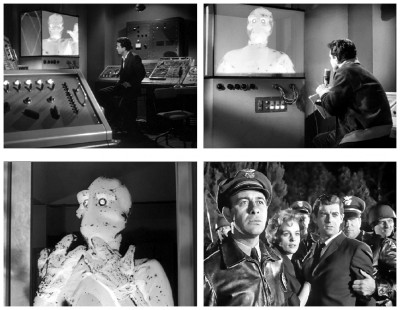 #1 THE GALAXY BEING written and directed by Leslie Stevens. Allan Maxwell (Cliff Robertson) has dedicated himself to researching microwave background noise using a device powered from his radio station. He inadvertently gets an extraterrestrial (William O. Douglas) from Andromeda on his three-dimensional television screen. Using his computer, Allan is able to translate the alien’s thought patterns into English. Both are conducting illicit experiments: Allan should not be using the radio station’s power, and the alien is forbidden to contact planets deemed dangerous. Allan and the alien have further enlightening philosophical conversations in which Allan learns that, “Infinity is God. God, infinity, all the same.” That evening Allan reluctantly leaves the radio station to attend a banquet in his honour, while leaving the channel to the alien open. Radio announcer Eddie Phillips (Burt Metcalfe), who is substituting for Allan’s brother Buddy Maxwell (Lee Philips), turns up the power to full, causing the alien to be transmitted to Earth as a solid electromagnetic being. It wreaks inadvertent havoc, killing Eddie and injuring several other people by burning them with natural radiation. The alien encounters Allan in person, who convinces it to turn down the heat, then guides it back to the transmitter shed. They are soon cornered by local authorities, who accidentally shoot Allan’s wife Carol (Jacqueline Scott). When the alien emerges, the authorities attempt to kill it, but it protects itself by destroying the weapons and transmitter tower with radiation. The mob is told, “There are powers in this universe beyond anything you know. There is much you have to learn. Go to your homes, go and give thought to the mysteries of the universe. I will leave you now in peace.” The alien is unable to return home due to violating his laws so, after assuring Allan that, “There is no death for me,” the alien self-destructs. This pilot episode perfectly embodies exactly what made the series so popular and memorable for so many viewers. With an eerie off-kilter atmosphere, a solid cast and a script that takes some genre stereotypes and nicely subverts them, this is a real pleasure for fans of great storytelling. Both the engineer and the extraterrestrial are variations of ‘Mad Scientist’ and ‘Alien Invader’ stereotypes, yet both are well-meaning and benevolent. The villain in this particular story is the angry mob of townspeople and authorities who gather to destroy the alien. There was plenty of speculation back then concerning radio contact with distant planets, in particular Project Ozma which eventually became known as S.E.T.I. (Search for Extra-Terrestrial Intelligence). It developed these themes further into a story about electronic existentialism, and tapped into themes prevalent in American culture at the time, including the televisation of the space-race and the fascination with television transmission in general. Like another Outer Limits episode entitled The Borderland, The Galaxy Being touches upon the subject of an ‘electronic limbo’ that exists when television signals cease transmission or are broadcast out into space, leaving us to wonder where the alien goes when he turns off the transmitter. Cliff Robertson, who plays Allan Maxwell, was in 633 Squadron (1964), Too Late The Hero (1970), Class (1983), The Honey Pot (1967), Obsession (1976), Brainstorm (1983), Escape From L.A. (1996), Spider-Man (2002), PT 109 (1963), and Charly (1968), which garnered him the Best Actor Oscar. Cliff could be found on the small-screen in Rod Brown Of The Rocket Rangers, The Twilight Zone and Batman. When he’s not acting up a storm, Cliff relaxes by collecting vintage fighter aircraft, including a Messerschmitt BF108, a Supermarine Spitfire, and several Tiger Moths, and was given the Good Will Aviation Award by the National Transportation Safety Association.
#1 THE GALAXY BEING written and directed by Leslie Stevens. Allan Maxwell (Cliff Robertson) has dedicated himself to researching microwave background noise using a device powered from his radio station. He inadvertently gets an extraterrestrial (William O. Douglas) from Andromeda on his three-dimensional television screen. Using his computer, Allan is able to translate the alien’s thought patterns into English. Both are conducting illicit experiments: Allan should not be using the radio station’s power, and the alien is forbidden to contact planets deemed dangerous. Allan and the alien have further enlightening philosophical conversations in which Allan learns that, “Infinity is God. God, infinity, all the same.” That evening Allan reluctantly leaves the radio station to attend a banquet in his honour, while leaving the channel to the alien open. Radio announcer Eddie Phillips (Burt Metcalfe), who is substituting for Allan’s brother Buddy Maxwell (Lee Philips), turns up the power to full, causing the alien to be transmitted to Earth as a solid electromagnetic being. It wreaks inadvertent havoc, killing Eddie and injuring several other people by burning them with natural radiation. The alien encounters Allan in person, who convinces it to turn down the heat, then guides it back to the transmitter shed. They are soon cornered by local authorities, who accidentally shoot Allan’s wife Carol (Jacqueline Scott). When the alien emerges, the authorities attempt to kill it, but it protects itself by destroying the weapons and transmitter tower with radiation. The mob is told, “There are powers in this universe beyond anything you know. There is much you have to learn. Go to your homes, go and give thought to the mysteries of the universe. I will leave you now in peace.” The alien is unable to return home due to violating his laws so, after assuring Allan that, “There is no death for me,” the alien self-destructs. This pilot episode perfectly embodies exactly what made the series so popular and memorable for so many viewers. With an eerie off-kilter atmosphere, a solid cast and a script that takes some genre stereotypes and nicely subverts them, this is a real pleasure for fans of great storytelling. Both the engineer and the extraterrestrial are variations of ‘Mad Scientist’ and ‘Alien Invader’ stereotypes, yet both are well-meaning and benevolent. The villain in this particular story is the angry mob of townspeople and authorities who gather to destroy the alien. There was plenty of speculation back then concerning radio contact with distant planets, in particular Project Ozma which eventually became known as S.E.T.I. (Search for Extra-Terrestrial Intelligence). It developed these themes further into a story about electronic existentialism, and tapped into themes prevalent in American culture at the time, including the televisation of the space-race and the fascination with television transmission in general. Like another Outer Limits episode entitled The Borderland, The Galaxy Being touches upon the subject of an ‘electronic limbo’ that exists when television signals cease transmission or are broadcast out into space, leaving us to wonder where the alien goes when he turns off the transmitter. Cliff Robertson, who plays Allan Maxwell, was in 633 Squadron (1964), Too Late The Hero (1970), Class (1983), The Honey Pot (1967), Obsession (1976), Brainstorm (1983), Escape From L.A. (1996), Spider-Man (2002), PT 109 (1963), and Charly (1968), which garnered him the Best Actor Oscar. Cliff could be found on the small-screen in Rod Brown Of The Rocket Rangers, The Twilight Zone and Batman. When he’s not acting up a storm, Cliff relaxes by collecting vintage fighter aircraft, including a Messerschmitt BF108, a Supermarine Spitfire, and several Tiger Moths, and was given the Good Will Aviation Award by the National Transportation Safety Association.
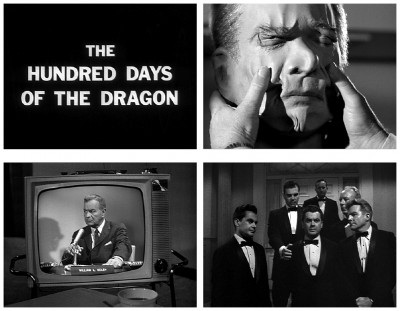 #2 THE HUNDRED DAYS OF THE DRAGON directed by Byron Haskin from a script by Allan Balter and Robert Mintz. The foreign communist nation of dictator Li Kwan (James Yagi) plans to take over the United States by substituting White House officials with lookalike spies. During the presidential campaign, candidate William Lyons Selby (Sidney Blackmer) is murdered and replaced by a lookalike. Selby is elected and the impostor assumes the office of the President of the United States. Though he fools the nation at large during his first few months in office, his daughter Carol (Nancy Rennick) begins to suspect that the man in the White House is not her father. She voices her concerns to Vice President Ted Pearson (Philip Pine) who disbelieves her at first, until he encounters an assassin with his face. Now convinced that Carol’s story is valid, Pearson informs the head of the Secret Service of the plot, and that Selby may be an impostor. After several failed attempts by the Secret Service in identifying Selby through dental records and other means, the leader of the Asian government reveals the second phase of their operation to substitute various heads of state and industry. When Selby arranges a second attempt at replacing his Vice President, the perpetrators are captured, brought before the President during a state reception and exposed, with the real Pearson charging him with murder and attempting to overthrow the United States government. Although a well-made episode, The Hundred Days Of The Dragon doesn’t seem to belong with the rest of the series. Primarily an espionage story, it has little to do with horror or science fiction, apart from a serum that briefly makes the flesh malleable, so a similar looking person could be made to look exactly like another. It’s an interesting plot, reminiscent of The Manchurian Candidate (1962) released the year before and, although the story is well-told and performed, it’s quite apparent the producers were still uncertain which direction the series might go. It’s also somewhat prophetic that the episode was broadcast on the 23rd of September, exactly sixty days before the assassination of President John F. Kennedy.
#2 THE HUNDRED DAYS OF THE DRAGON directed by Byron Haskin from a script by Allan Balter and Robert Mintz. The foreign communist nation of dictator Li Kwan (James Yagi) plans to take over the United States by substituting White House officials with lookalike spies. During the presidential campaign, candidate William Lyons Selby (Sidney Blackmer) is murdered and replaced by a lookalike. Selby is elected and the impostor assumes the office of the President of the United States. Though he fools the nation at large during his first few months in office, his daughter Carol (Nancy Rennick) begins to suspect that the man in the White House is not her father. She voices her concerns to Vice President Ted Pearson (Philip Pine) who disbelieves her at first, until he encounters an assassin with his face. Now convinced that Carol’s story is valid, Pearson informs the head of the Secret Service of the plot, and that Selby may be an impostor. After several failed attempts by the Secret Service in identifying Selby through dental records and other means, the leader of the Asian government reveals the second phase of their operation to substitute various heads of state and industry. When Selby arranges a second attempt at replacing his Vice President, the perpetrators are captured, brought before the President during a state reception and exposed, with the real Pearson charging him with murder and attempting to overthrow the United States government. Although a well-made episode, The Hundred Days Of The Dragon doesn’t seem to belong with the rest of the series. Primarily an espionage story, it has little to do with horror or science fiction, apart from a serum that briefly makes the flesh malleable, so a similar looking person could be made to look exactly like another. It’s an interesting plot, reminiscent of The Manchurian Candidate (1962) released the year before and, although the story is well-told and performed, it’s quite apparent the producers were still uncertain which direction the series might go. It’s also somewhat prophetic that the episode was broadcast on the 23rd of September, exactly sixty days before the assassination of President John F. Kennedy.
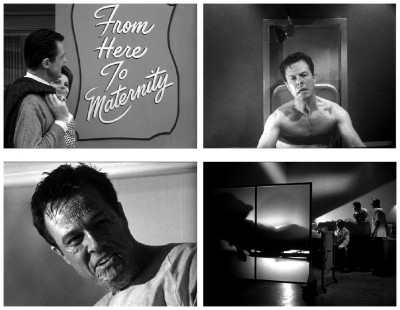 #3 THE ARCHITECTS OF FEAR directed by Byron Haskin from a script by Meyer Dolinsky. A idealistic group of scientists decide to surgically alter one of their members into an ‘extraterrestrial’ in order to convince the world that an alien invasion is imminent and to unite all humanity against a perceived common enemy. The scientists draw lots, and physicist Allen Leighton (Robert Culp) is chosen to undergo radical surgical procedures that will transform him into an inhabitant of the planet Theta. Leighton’s death is faked, and the bizarre series of transplants and modifications to his body proceed. His wife Yvette (Geraldine Brooks) is in denial, and feels sympathetic pain as Allen suffers on the operating table. The plan is for Allen, as the Thetan, to land his spaceship outside the United Nations building in an effort to create a panic, but the mission goes awry when the spaceship goes off-course and lands in a forest near the laboratory. Allen is shot by frightened duck hunters and, in an attempt to heal his wounds, stumbles back to the laboratory. Meanwhile Yvette hurries to the lab looking for her husband, arriving just as the Thetan enters and collapses to the floor dead.
#3 THE ARCHITECTS OF FEAR directed by Byron Haskin from a script by Meyer Dolinsky. A idealistic group of scientists decide to surgically alter one of their members into an ‘extraterrestrial’ in order to convince the world that an alien invasion is imminent and to unite all humanity against a perceived common enemy. The scientists draw lots, and physicist Allen Leighton (Robert Culp) is chosen to undergo radical surgical procedures that will transform him into an inhabitant of the planet Theta. Leighton’s death is faked, and the bizarre series of transplants and modifications to his body proceed. His wife Yvette (Geraldine Brooks) is in denial, and feels sympathetic pain as Allen suffers on the operating table. The plan is for Allen, as the Thetan, to land his spaceship outside the United Nations building in an effort to create a panic, but the mission goes awry when the spaceship goes off-course and lands in a forest near the laboratory. Allen is shot by frightened duck hunters and, in an attempt to heal his wounds, stumbles back to the laboratory. Meanwhile Yvette hurries to the lab looking for her husband, arriving just as the Thetan enters and collapses to the floor dead.
 Excellent performances all around, but this episode is exemplary because of screenwriter Meyer Dolinsky and director Byron Haskin. The main premise is treated seriously and every subsequent stage of the plan is shown with more and more disturbing repercussions. The ‘Bear’ in this episode, the monstrously-altered Allen Leighton, was judged by some television stations as to be so frightening that they blacked out the screen during the Thetan’s appearances, censoring most of the show’s climax. In other parts of the United States the Thetan footage was delayed until after the 11pm evening news, In others it was not shown at all. The theory behind this episode, that the world would reunite if faced by a common enemy, is not unlike the theory presented at the end of Watchmen (2009) by Alan Moore and Dave Gibbons. According to Moore, he came across this episode while writing issue ten and was surprised by its similarity to his already planned ending. The editor of the comic series, Len Wein, stated that, “It simply stole the ending to an episode of The Outer Limits, which Alan fully admitted,” and quit because Moore refused to change it. This was the first Outer Limits role for actor Robert Culp, who would return for both Corpus Earthling and Demon With A Glass Hand, and would make more than 170 film and television appearances until his passing in 2010.
Excellent performances all around, but this episode is exemplary because of screenwriter Meyer Dolinsky and director Byron Haskin. The main premise is treated seriously and every subsequent stage of the plan is shown with more and more disturbing repercussions. The ‘Bear’ in this episode, the monstrously-altered Allen Leighton, was judged by some television stations as to be so frightening that they blacked out the screen during the Thetan’s appearances, censoring most of the show’s climax. In other parts of the United States the Thetan footage was delayed until after the 11pm evening news, In others it was not shown at all. The theory behind this episode, that the world would reunite if faced by a common enemy, is not unlike the theory presented at the end of Watchmen (2009) by Alan Moore and Dave Gibbons. According to Moore, he came across this episode while writing issue ten and was surprised by its similarity to his already planned ending. The editor of the comic series, Len Wein, stated that, “It simply stole the ending to an episode of The Outer Limits, which Alan fully admitted,” and quit because Moore refused to change it. This was the first Outer Limits role for actor Robert Culp, who would return for both Corpus Earthling and Demon With A Glass Hand, and would make more than 170 film and television appearances until his passing in 2010.
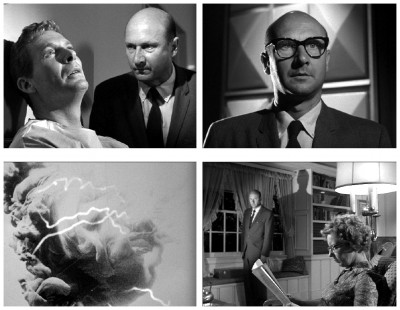 #4 THE MAN WITH THE POWER directed by László Benedek from a script by Jerome Ross. Henpecked husband and college teacher Harold (Donald Pleasence) is unable to stand up to anyone, especially his shrewish wife (Priscilla Morrill) but, after neurosurgery enhances his latent telekinetic abilities, Harold’s anger begins to manifest itself as a physical force. Space scientists are thrilled at his conscious ability to focus massive energy and assist them in retrieving unreachable space-bound asteroids. As a young astronaut (Fred Bier) is about to undergo the same surgery, Harold – now realising its destructive power – becomes alarmed and attempts to stop the procedure. He bursts into the operating theatre and kills not only the surgeon and the head of the project, but also himself. This is a very mature and intelligent piece about power, how it needs to be controlled and how too much can be damaging, not unlike the moral behind Forbidden Planet (1956). When The Outer Limits travels to the inner mind, it makes for some impressively intense moments, helped immensely as usual by the choice cast. Donald Pleasence has rarely been less than great and here he exudes class and skill from start to finish with his wonderful portrayal of Harold Finley, a man who has never managed to get where he wanted in life and blames much of his failure on his bitchy wife. Fred Beir and Edward Platt have very different roles – with Platt as the college dean who doesn’t care for Harold’s extracurricular activities – but both provide equally solid performances, and both actors will reappear in future episodes of The Outer Limits.
#4 THE MAN WITH THE POWER directed by László Benedek from a script by Jerome Ross. Henpecked husband and college teacher Harold (Donald Pleasence) is unable to stand up to anyone, especially his shrewish wife (Priscilla Morrill) but, after neurosurgery enhances his latent telekinetic abilities, Harold’s anger begins to manifest itself as a physical force. Space scientists are thrilled at his conscious ability to focus massive energy and assist them in retrieving unreachable space-bound asteroids. As a young astronaut (Fred Bier) is about to undergo the same surgery, Harold – now realising its destructive power – becomes alarmed and attempts to stop the procedure. He bursts into the operating theatre and kills not only the surgeon and the head of the project, but also himself. This is a very mature and intelligent piece about power, how it needs to be controlled and how too much can be damaging, not unlike the moral behind Forbidden Planet (1956). When The Outer Limits travels to the inner mind, it makes for some impressively intense moments, helped immensely as usual by the choice cast. Donald Pleasence has rarely been less than great and here he exudes class and skill from start to finish with his wonderful portrayal of Harold Finley, a man who has never managed to get where he wanted in life and blames much of his failure on his bitchy wife. Fred Beir and Edward Platt have very different roles – with Platt as the college dean who doesn’t care for Harold’s extracurricular activities – but both provide equally solid performances, and both actors will reappear in future episodes of The Outer Limits.
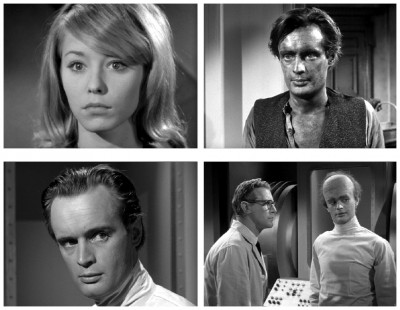 #5 THE SIXTH FINGER directed by James Goldstone from a script by Ellis St. Joseph. In a remote Welsh mining town, rogue scientist Professor Mathers (Edward Mulhare) develops a process that can change the speed of evolutionary mutation. Disgruntled miner Gwyllm Griffiths (David McCallum) volunteers for the experiment, enabling the professor to create a being with enhanced mental capabilities. After twenty thousand years of evolution, Gwyllm grows an overdeveloped cortex and a sixth finger on each hand. When the mutation process begins to operate independently of the professor’s influence, Gwyllm takes control of the experiment. Now equal to a million years of evolution and equipped with superior intelligence and telekinesis, Gwyllm seeks vengeance on the mining town he loathes, but changes his mind as he evolves beyond concepts such as love and hate, and instead intends to turn himself into a vortex of pure intellect with the help of his girlfriend Cathy (Jill Haworth). At the last moment, Cathy reverses the process instead, bringing Gwyllm back to his former self, but the reversal proves too much for Gwyllm, who succumbs to the adverse effects while she comforts him.
#5 THE SIXTH FINGER directed by James Goldstone from a script by Ellis St. Joseph. In a remote Welsh mining town, rogue scientist Professor Mathers (Edward Mulhare) develops a process that can change the speed of evolutionary mutation. Disgruntled miner Gwyllm Griffiths (David McCallum) volunteers for the experiment, enabling the professor to create a being with enhanced mental capabilities. After twenty thousand years of evolution, Gwyllm grows an overdeveloped cortex and a sixth finger on each hand. When the mutation process begins to operate independently of the professor’s influence, Gwyllm takes control of the experiment. Now equal to a million years of evolution and equipped with superior intelligence and telekinesis, Gwyllm seeks vengeance on the mining town he loathes, but changes his mind as he evolves beyond concepts such as love and hate, and instead intends to turn himself into a vortex of pure intellect with the help of his girlfriend Cathy (Jill Haworth). At the last moment, Cathy reverses the process instead, bringing Gwyllm back to his former self, but the reversal proves too much for Gwyllm, who succumbs to the adverse effects while she comforts him.
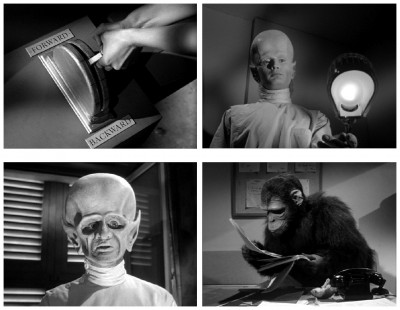 This is another top-notch episode despite some elements that may provoke unintentional giggles, such as the changing appearance of Gwyllm. It’s not only an interesting look at the central character but also the human race in general and where it now stands in the grand scheme of evolution. The acting however is a very mixed bag. McCallum (before starring in The Man From UNCLE, Colditz, The Invisible Man and NCIS) does well despite being hidden by makeup, as does Edward Mulhare (before starring in The Ghost And Mrs. Muir and Knight Rider). There’s also Jill Haworth, a sweet and lovely young woman playing the sweet and lovely Cathy Evans. But Robert Doyle isn’t that great and Constance Cavendish deserves a prize for one of the most mangled accents ever heard – it’s obvious what accent she’s aiming for but never gets it right. A number of scenes and characters were removed from the original script to save money, including five speaking roles: Policeman Wilks, Cathy’s father Bryn, mine-owner Caradoc, and two miners named Robbart and Emlyn. Gwyllm’s vengeful rampage against the mine was removed, and the dialogue between Gwyllm and Professor Mathers at the end of Act Three was originally slightly longer. This shortened script was only forty minutes long so, to fill the gap, the sequence of Gwyllm discovering music was quickly written as a five-minute insert by Joseph Stefano. The censors objected to the Darwinism and promotion of evolution inherent in the story, and one of the first deletions was a speech by Mathers on the subject: “In the short span of nine months, every human embryo passes through a million years of its previous evolution, from protoplasm to fish, to amphibian, to furry ape with a tail, to man. I’m experimenting with a means of continuing this process in the same lifetime.” In the original script Gwyllm devolves into a jellyfish, but the censors would only allow him to regress to early man, due to concerns that religious viewers would be offended.
This is another top-notch episode despite some elements that may provoke unintentional giggles, such as the changing appearance of Gwyllm. It’s not only an interesting look at the central character but also the human race in general and where it now stands in the grand scheme of evolution. The acting however is a very mixed bag. McCallum (before starring in The Man From UNCLE, Colditz, The Invisible Man and NCIS) does well despite being hidden by makeup, as does Edward Mulhare (before starring in The Ghost And Mrs. Muir and Knight Rider). There’s also Jill Haworth, a sweet and lovely young woman playing the sweet and lovely Cathy Evans. But Robert Doyle isn’t that great and Constance Cavendish deserves a prize for one of the most mangled accents ever heard – it’s obvious what accent she’s aiming for but never gets it right. A number of scenes and characters were removed from the original script to save money, including five speaking roles: Policeman Wilks, Cathy’s father Bryn, mine-owner Caradoc, and two miners named Robbart and Emlyn. Gwyllm’s vengeful rampage against the mine was removed, and the dialogue between Gwyllm and Professor Mathers at the end of Act Three was originally slightly longer. This shortened script was only forty minutes long so, to fill the gap, the sequence of Gwyllm discovering music was quickly written as a five-minute insert by Joseph Stefano. The censors objected to the Darwinism and promotion of evolution inherent in the story, and one of the first deletions was a speech by Mathers on the subject: “In the short span of nine months, every human embryo passes through a million years of its previous evolution, from protoplasm to fish, to amphibian, to furry ape with a tail, to man. I’m experimenting with a means of continuing this process in the same lifetime.” In the original script Gwyllm devolves into a jellyfish, but the censors would only allow him to regress to early man, due to concerns that religious viewers would be offended.
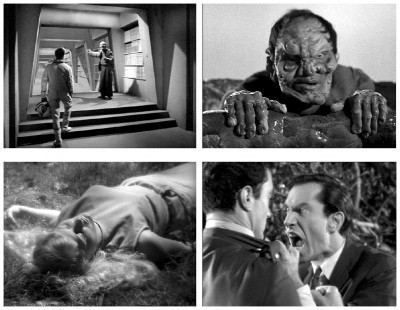 #6 THE MAN WHO WAS NEVER BORN directed by Leonard Horn from a script by Anthony Lawrence. An astronaut named Joseph Reardon (Karl Held) is forced to land following an encounter with a spatial anomaly, only to find the Earth is a desolate post-apocalyptic realm. He meets Andro (Martin Landau), a horribly mutated human, who says that the year is 2148 and that Reardon has crossed over into the future. Andro is one of the few remaining survivors of a biological disaster brought on by an ambitious scientist named Bertram Cabot Junior, who had developed a viral symbiont from an interstellar microbe which physically altered the human race. Andro laments the lack of hope for the human race, so Reardon decides to see if he can return to his own time, taking Andro with him as proof of the fate of the human race and perhaps prevent it. Reardon dies on the return trip, telling Andro to kill Cabot if he has no other alternative, and prevent his disastrous future from occurring. Using hypnotic suggestion, Andro can appear as a normal human and uses this ability to begin searching for some way to stop Cabot’s work, but it soon becomes obvious he has arrived too early. Bertram Cabot Junior has not even been born yet and his parents, Noelle Anderson (Shelley Knight) and Bertram Cabot (John Considine), are soon to be married. Disguised as a human, Andro fails to convince Cabot that he should not marry. While attempting to shoot Cabot during the wedding, Andro is assaulted revealing his true appearance, and is forced to flee. Noelle follows him – he explains his mission, and Noelle confesses her love for Andro. She convinces him to take her with him to the future, thereby avoiding any possibility that she and Cabot will have a child. They take-off for the year 2148 but, due to his actions, Andro ceases to exist just as the ship arrives, leaving Noelle weeping in the darkness to face this ‘new’ future alone. The story is quite interesting and the acting by all is top-notch. The early sixties were thankfully filled with such interesting and intellectual programs in this vein. Both The Outer Limits and The Twilight Zone offered grand insights, smart writing and brilliant acting in spades! At this writing, both Martin Landau and Shirley Knight are alive and well, with more than 170 film and television credits – each!
#6 THE MAN WHO WAS NEVER BORN directed by Leonard Horn from a script by Anthony Lawrence. An astronaut named Joseph Reardon (Karl Held) is forced to land following an encounter with a spatial anomaly, only to find the Earth is a desolate post-apocalyptic realm. He meets Andro (Martin Landau), a horribly mutated human, who says that the year is 2148 and that Reardon has crossed over into the future. Andro is one of the few remaining survivors of a biological disaster brought on by an ambitious scientist named Bertram Cabot Junior, who had developed a viral symbiont from an interstellar microbe which physically altered the human race. Andro laments the lack of hope for the human race, so Reardon decides to see if he can return to his own time, taking Andro with him as proof of the fate of the human race and perhaps prevent it. Reardon dies on the return trip, telling Andro to kill Cabot if he has no other alternative, and prevent his disastrous future from occurring. Using hypnotic suggestion, Andro can appear as a normal human and uses this ability to begin searching for some way to stop Cabot’s work, but it soon becomes obvious he has arrived too early. Bertram Cabot Junior has not even been born yet and his parents, Noelle Anderson (Shelley Knight) and Bertram Cabot (John Considine), are soon to be married. Disguised as a human, Andro fails to convince Cabot that he should not marry. While attempting to shoot Cabot during the wedding, Andro is assaulted revealing his true appearance, and is forced to flee. Noelle follows him – he explains his mission, and Noelle confesses her love for Andro. She convinces him to take her with him to the future, thereby avoiding any possibility that she and Cabot will have a child. They take-off for the year 2148 but, due to his actions, Andro ceases to exist just as the ship arrives, leaving Noelle weeping in the darkness to face this ‘new’ future alone. The story is quite interesting and the acting by all is top-notch. The early sixties were thankfully filled with such interesting and intellectual programs in this vein. Both The Outer Limits and The Twilight Zone offered grand insights, smart writing and brilliant acting in spades! At this writing, both Martin Landau and Shirley Knight are alive and well, with more than 170 film and television credits – each!
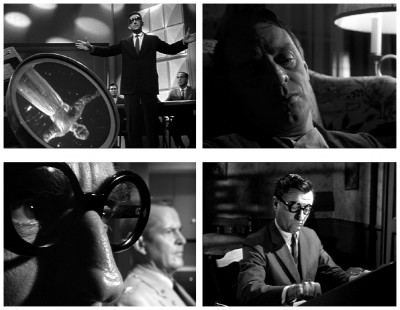 #7 O.B.I.T. directed by Gerd Oswald from a script by Meyer Dolinsky. While inquiring into the death of an administrator at a government research facility, Senator Orville (Peter Breck) is confronted with paranoia, secrecy and intimidation. He ultimately learns the cause, an unusual security device that is used to monitor its employees. The Outer Band Individuated Teletracer – or O.B.I.T. – is a remarkable technology that can track and monitor any individual anywhere for any length of time. After a missing administrator named Lomax (Jeff Corey) is found and reveals his knowledge of the machine, its sinister unearthly origins and purpose become apparent. The device is actually an alien invention designed to demoralise and desensitise the human race in preparation for invasion. “The machines are everywhere! Oh, you’ll find them all, you’re a zealous people, and you’ll make a great show of smashing a few of them. But for every one you destroy, hundreds of others will be built and they will demoralise you, break your spirits, create such rifts and tensions in your society that no one will be able to repair them! You’re a savage despairing planet and, when we come here to live, you friendless demoralised flotsam will fall without even a single shot being fired. Senator, enjoy the few years left to you. There is no answer, you’re all of the same dark persuasion. You demand and insist on knowing every private thought and hunger of everyone, your families, your neighbours, everyone but yourselves!” This episode takes place mostly in a hearing room at a secret government installation where the O.B.I.T. machine was created and it’s because of this I recommend you stick with this one until the very end and its excellent payoff. Until then, expect a rather claustrophobic story that is virtually a one-room drama.
#7 O.B.I.T. directed by Gerd Oswald from a script by Meyer Dolinsky. While inquiring into the death of an administrator at a government research facility, Senator Orville (Peter Breck) is confronted with paranoia, secrecy and intimidation. He ultimately learns the cause, an unusual security device that is used to monitor its employees. The Outer Band Individuated Teletracer – or O.B.I.T. – is a remarkable technology that can track and monitor any individual anywhere for any length of time. After a missing administrator named Lomax (Jeff Corey) is found and reveals his knowledge of the machine, its sinister unearthly origins and purpose become apparent. The device is actually an alien invention designed to demoralise and desensitise the human race in preparation for invasion. “The machines are everywhere! Oh, you’ll find them all, you’re a zealous people, and you’ll make a great show of smashing a few of them. But for every one you destroy, hundreds of others will be built and they will demoralise you, break your spirits, create such rifts and tensions in your society that no one will be able to repair them! You’re a savage despairing planet and, when we come here to live, you friendless demoralised flotsam will fall without even a single shot being fired. Senator, enjoy the few years left to you. There is no answer, you’re all of the same dark persuasion. You demand and insist on knowing every private thought and hunger of everyone, your families, your neighbours, everyone but yourselves!” This episode takes place mostly in a hearing room at a secret government installation where the O.B.I.T. machine was created and it’s because of this I recommend you stick with this one until the very end and its excellent payoff. Until then, expect a rather claustrophobic story that is virtually a one-room drama.
 #8 THE HUMAN FACTOR directed by Abner Biberman from a script by David Duncan. At an isolated military installation in Greenland, Major Brothers (Harry Guardino) has accidentally allowed one of his men to fall to his death. Mentally haunted by a spectre of the dead man, Brothers decides he must detonate an atomic device to obliterate the crevasse along with the installation and any evidence of incompetence, to purge himself of his emotional anguish. He goes to Doctor Hamilton (Gary Merrill), who has invented a device that allows him to read the thoughts of another person. Hamilton and Brothers connect via the device, but then a power surge causes the minds of the two men swap bodies. The deranged Major Brothers, bent on destroying the base, is now in Hamilton’s body, and the other base workers know nothing of the mind-swap. This new identity enables the insane Major to set about his plan for destruction, with the real doctor – now in the body of the disturbed officer – confined to a padded cell desperately trying to warn everyone of their impending doom.
#8 THE HUMAN FACTOR directed by Abner Biberman from a script by David Duncan. At an isolated military installation in Greenland, Major Brothers (Harry Guardino) has accidentally allowed one of his men to fall to his death. Mentally haunted by a spectre of the dead man, Brothers decides he must detonate an atomic device to obliterate the crevasse along with the installation and any evidence of incompetence, to purge himself of his emotional anguish. He goes to Doctor Hamilton (Gary Merrill), who has invented a device that allows him to read the thoughts of another person. Hamilton and Brothers connect via the device, but then a power surge causes the minds of the two men swap bodies. The deranged Major Brothers, bent on destroying the base, is now in Hamilton’s body, and the other base workers know nothing of the mind-swap. This new identity enables the insane Major to set about his plan for destruction, with the real doctor – now in the body of the disturbed officer – confined to a padded cell desperately trying to warn everyone of their impending doom.
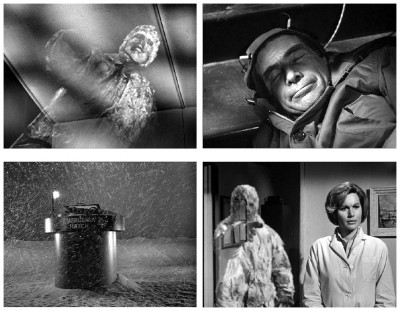 When Hamilton’s assistant Ingrid (Sally Kellerman) reads his notes, she learns of the possible mind-swap, and talks with Brothers in his cell about his claims of really being the doctor. He convinces her that he is actually the doctor by revealing an intimate detail regarding their relationship and she helps him to escape. Meanwhile, Brothers attempts to obtain information on how to detonate the bomb, and is ordered to return to the doctor’s office, where he encounters Hamilton and Ingrid. Brothers tries to kill Hamilton, and is mortally wounded in the attempt. Hamilton attaches the electrodes from the mind probe machine to himself and to Brothers. Just before Brothers dies, Hamilton’s mind his successfully returned to his own body. Both Hamilton and Ingrid try to make sense of the ordeal and wonder how to explain the unbelievable circumstances surrounding the Major’s death, deciding to simply tell the truth, that Major Brothers shot himself. Admittedly, this is a rather ordinary episode, neither good nor bad. While the idea is far-fetched, both Guardino and Merrill do a great job and manage to make the ridiculous seem possible. Not exactly brilliant, but definitely worth viewing, though the ending is oddly rather sweet in some ways, and you should keep an eye out (ow!) for future television stars Ivan Dixon and James Sikking as well. Sally Kellerman returns to The Outer Limits in the episode The Bellero Shield, going on to star in the second Star Trek pilot Where No Man Has Gone Before and the movie M*A*S*H (1970) as the original Hotlips Houlihan.
When Hamilton’s assistant Ingrid (Sally Kellerman) reads his notes, she learns of the possible mind-swap, and talks with Brothers in his cell about his claims of really being the doctor. He convinces her that he is actually the doctor by revealing an intimate detail regarding their relationship and she helps him to escape. Meanwhile, Brothers attempts to obtain information on how to detonate the bomb, and is ordered to return to the doctor’s office, where he encounters Hamilton and Ingrid. Brothers tries to kill Hamilton, and is mortally wounded in the attempt. Hamilton attaches the electrodes from the mind probe machine to himself and to Brothers. Just before Brothers dies, Hamilton’s mind his successfully returned to his own body. Both Hamilton and Ingrid try to make sense of the ordeal and wonder how to explain the unbelievable circumstances surrounding the Major’s death, deciding to simply tell the truth, that Major Brothers shot himself. Admittedly, this is a rather ordinary episode, neither good nor bad. While the idea is far-fetched, both Guardino and Merrill do a great job and manage to make the ridiculous seem possible. Not exactly brilliant, but definitely worth viewing, though the ending is oddly rather sweet in some ways, and you should keep an eye out (ow!) for future television stars Ivan Dixon and James Sikking as well. Sally Kellerman returns to The Outer Limits in the episode The Bellero Shield, going on to star in the second Star Trek pilot Where No Man Has Gone Before and the movie M*A*S*H (1970) as the original Hotlips Houlihan.
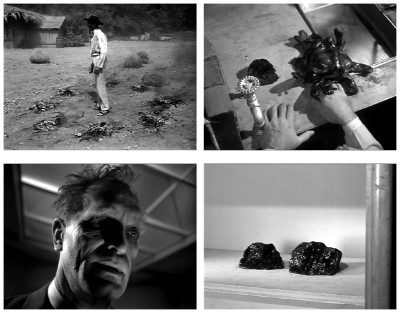 #9 CORPUS EARTHLING directed by Gerd Oswald from a script by Orin Borstein and Louis Charbonneau. Intelligent parasitic extraterrestrials resembling ordinary rocks intend to enslave the human race, and find a perfect base of operations in the laboratory of geologist Jonas Temple (Barry Atwater). Although undetected by ordinary humans, Paul Cameron (Robert Culp) is able to hear the alien rocks communicate with each other due to a surgically implanted metal plate in his skull. Aware that he can hear them, the alien rocks realise he’s a threat and compel Cameron to kill himself, but he is saved when his wife Laurie (Salome Jens) breaks the alien’s mind control. Thinking he’s going insane, Paul takes an impulsive vacation to Mexico with Laurie to help clear his troubled mind. Temple, now controlled by one of the extraterrestrials, pursues them. In Mexico, Laurie becomes possessed after Temple finds her alone in the remote desert cabin, and is commanded by the aliens to possess her husband upon his return. Fighting for his life, Cameron stabs Temple and shoots Laurie, forcing the aliens to evacuate their bodies, thus revealing their true form – hideous shiny-black crab-like beings with glowing eyes. He sets fire to the cabin destroying the aliens, and carries Laurie’s seemingly lifeless body away from the blaze. Salome Jens gives a terrific performance and, although the aliens look like obvious puppets, its scuttling quick movements make for some good shocking moments. The film Noir look is perfectly achieved and helps make this low budget television episode look both cinematic and scary. Far from being the weakest story, this has become one of the favourites of the first season. At first, when two rubbery rocks on a shelf start talking to each other like Pinky And The Brain, I expected the worst episode of the season but, once the alien possession plot begins in earnest, the story quickly improves. The last act is quite frighteningly intense and comes to a bravely downbeat conclusion. In the original novel by Louis Charbonneau, Cameron is an unmarried university lecturer who desires one of his students named Laurie. He is actually a latent telepath who has been compelled to attempt suicide on at least three occasions by an alien force that refers to him as ‘The Listener’. The invaders were brought to Earth with the first geological samples from Mars. Temple is the first to be possessed when he touches the alien rocks with his tongue, and diagnoses Cameron as schizophrenic. Barry Atwater, who portrays Temple, is a stone-faced character actor best remembered as the vampire Janos Skorzeny in The Night Stalker (1972) and the venerable father of Vulcan philosophy Surak in Star Trek.
#9 CORPUS EARTHLING directed by Gerd Oswald from a script by Orin Borstein and Louis Charbonneau. Intelligent parasitic extraterrestrials resembling ordinary rocks intend to enslave the human race, and find a perfect base of operations in the laboratory of geologist Jonas Temple (Barry Atwater). Although undetected by ordinary humans, Paul Cameron (Robert Culp) is able to hear the alien rocks communicate with each other due to a surgically implanted metal plate in his skull. Aware that he can hear them, the alien rocks realise he’s a threat and compel Cameron to kill himself, but he is saved when his wife Laurie (Salome Jens) breaks the alien’s mind control. Thinking he’s going insane, Paul takes an impulsive vacation to Mexico with Laurie to help clear his troubled mind. Temple, now controlled by one of the extraterrestrials, pursues them. In Mexico, Laurie becomes possessed after Temple finds her alone in the remote desert cabin, and is commanded by the aliens to possess her husband upon his return. Fighting for his life, Cameron stabs Temple and shoots Laurie, forcing the aliens to evacuate their bodies, thus revealing their true form – hideous shiny-black crab-like beings with glowing eyes. He sets fire to the cabin destroying the aliens, and carries Laurie’s seemingly lifeless body away from the blaze. Salome Jens gives a terrific performance and, although the aliens look like obvious puppets, its scuttling quick movements make for some good shocking moments. The film Noir look is perfectly achieved and helps make this low budget television episode look both cinematic and scary. Far from being the weakest story, this has become one of the favourites of the first season. At first, when two rubbery rocks on a shelf start talking to each other like Pinky And The Brain, I expected the worst episode of the season but, once the alien possession plot begins in earnest, the story quickly improves. The last act is quite frighteningly intense and comes to a bravely downbeat conclusion. In the original novel by Louis Charbonneau, Cameron is an unmarried university lecturer who desires one of his students named Laurie. He is actually a latent telepath who has been compelled to attempt suicide on at least three occasions by an alien force that refers to him as ‘The Listener’. The invaders were brought to Earth with the first geological samples from Mars. Temple is the first to be possessed when he touches the alien rocks with his tongue, and diagnoses Cameron as schizophrenic. Barry Atwater, who portrays Temple, is a stone-faced character actor best remembered as the vampire Janos Skorzeny in The Night Stalker (1972) and the venerable father of Vulcan philosophy Surak in Star Trek.
 Horror News | HNN Official Site | Horror Movies,Trailers, Reviews
Horror News | HNN Official Site | Horror Movies,Trailers, Reviews
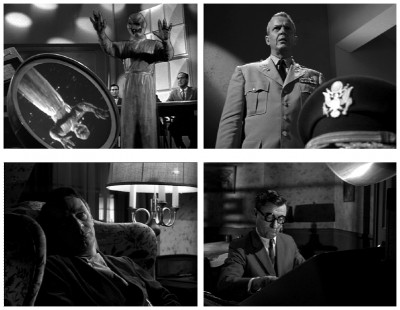

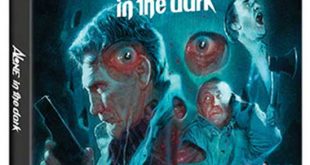




This was my true scary TV show when I was a kid. Dracula movies and others didn’t cut it, but this series certainly did. I remember that hideous non-humanoid presence in The Guests, glowing in the dark, when I was eight years old. I was almost scared to bits, with my hairs standing on end, and was made leery of dark hallways for many years. These episodes seemed to tap into a covert existential corner of my awareness at that tender age; the little-known writer Fritz Kunkel would likely have thought deeply of this, had he still been alive. I have this well-restored footage on DVD, and watch my favorites from time to time. I thank Leslie Stevens, George Stefano, and others for this audaciously crafted mind-stimulating material; I doubt other thrillers quite approach this, except for that paranormal series: One Step Beyond.